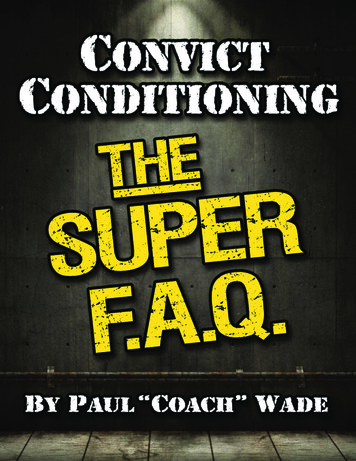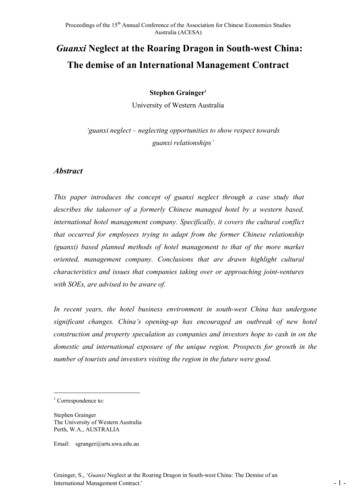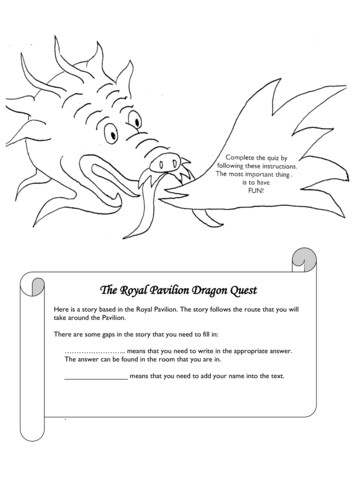
Transcription
CONVICT CONDITIONINGTHE SUPER F.A.Q.um writer. (Given the endless help II’m painfully aware that I’m a crumblifyng Convict Condi tioning, I barely quareceived editing, re-editing and proofiailss first published, I’ve got stacks of emas a writer at all!) Since the book wawamethods I set down. Often I stheofsectaspentferdifutabosderfrom reaseover. In the vast majority of cases, theandrovens,stioqueesamtheiledmaTheen I was training students hands-on.were questions I never got asked whsk were just not as clear as my readerobvious conclusion? Parts of the boou.a. “The Boss”) offered me the opportdeserved. So when John Du Cane (a.koffndoor.com, I nearly bit his arm .ragoDofrsuseforingethsomitenity to wrents my opportunity to clear up anyThis F.A.Q. is the end result. It represue org strength system that might seem vagaspects of the Convict Condi tioninre, soand I got no desire to be a public figuambiguous. I’m not an internet guy,on these matters. If you havesayalfinmysentresrepoalsAsQ&this batch ofe a specific question you’ll probahavandginintranowryouinkbooused mybly find my answer to you in here.ce on your site; thanks also to BrettThanks John, for allowing me this spasome of these answers. I’d also like toJones for looking at (and correcting)world who sent me questions. Manytheundarotsdenstuandndsfriethank myponses, have been replicated word forresmyhwitteplecomns,stioqueseof theword in this F.A.Q.line—without you making bodyA final shout out goes to Pavel Tsatsouhave got published in the first place.weight training cool again, I wouldn’tThanks, man.—P aul John Wadewww.dragondoor.com1 800 899 5111Order Convict Conditioning online:www.dragondoor.com/B41
TABLE OF CONTENTS ——Convict Conditioning—the basicsDoes every athlete need to start at the first steps?1Why are there always ten steps?2How long until I can move to the next step?3How long will it take to reach the Master Steps?4Can I do my exercises faster?5Is CC only good for beginners?6Taking it to the next level6Programming: Volume,intensity, frequency, routinesWhy such short workouts?7Bodyweight training: the key to not quitting8Working to failure9Why do the progression standards require high (20 ) reps?11Why can’t I work the same bodyweight exercises every day?12Is it okay to explore alternative programs?14Higher frequency program templates15Specific techniquesDifficulty getting beyond the horizontal pull20Are one-arm handstand pushups possible?21Why are hanging leg raises the easiest Master Step?22Mastering the uneven squat23Notes on the prison pushup24www.dragondoor.com1 800 899 5111Order Convict Conditioning online:www.dragondoor.com/B41
More prison trainingWill there be a sequel to Convict Conditioning?26Where’s the grip, calf and neck work?27Adding bodyweight into a regular weights program28Prison cardio28Diet and prison training29Miscellaneous topicsConvict Conditioning and kettlebells30Convict Conditioning vs gymnastics31Pushup handles?33Convict Conditioning and flexibility34Thoughts on Twilight35Do I need periodization?35Convict Conditioning and plyometrics36Thoughts on the role of negatives38Is Convict Conditioning safe for kids?39www.dragondoor.com1 800 899 5111Order Convict Conditioning online:www.dragondoor.com/B41
1CONVICT CONDITIONING: THE SUPER F.A.Q.CONVICT CONDITIONING—THE BASICSIs it necessary to always start at thefirst steps for the progressions?First off, it should go without saying that you should always start from step 1 of each progression if you are: Out-of-shapeA beginnerCarrying an injury, orLacking in confidenceIt’s tough to talk about where an intermediate or advanced athlete should start when beginninga Convict Conditioning-based workout. It’s tough because all athletes are different, but alsobecause—in my experience—most athletes (especially young males) tend to overestimate theirown athletic prowess. Many times, I’ve seen athletes skip earlier steps, convinced that they’re awaste of time and energy. But those early steps are there for a reason. They gradually condition thejoints and soft tissues, build coordination and skill, and kick-start the slow process of buildingpermanent energy supplies into the muscle cells. Those same impatient athletes often either quitfrom aches and pains, or they find they eventually seem to suddenly “hit a wall” in their workouts. This is because they never took the time to gradually build momentum; they never “banked”strength from the early steps to help them carry their way through the later, more advanced steps.Intermediate or advanced athletes will probably want to think about starting from steps higherup the series; but this is a decision they should make very carefully. I know a lot of very advanced,powerful inmates who have scoffed at the idea of starting from the initial steps. Taking two oreven three months on “easy” exercises can seem frustrating and unproductive. But once they’veworked through the easier exercises, they often feel like new men. Old injuries begin to heal; thejoints and tissues become more flexible; the nervous system “reboots” and a new, rock solid set ofbalance and coordination patterns begin to dominate. Motivation skyrockets.Isn’t it worth investing a couple months of your life-long training career for that kind of payoff?Jesus, most of the bodybuilders I know lay off or vacation for at least two months a year!To answer the initial question: no. Advanced trainees don’t necessarily need to start with thefirst steps. But starting with the first steps is never, ever a waste of time.www.dragondoor.com1 800 899 5111Order Convict Conditioning online:www.dragondoor.com/B41
2CONVICT CONDITIONING: THE SUPER F.A.Q.I notice you feel the need touniversally lay out “ten steps" for eachmovement, no matter what it is.I think this makes your systemartificial. Why are there ten exercisesfor each of the Big Six?There aren't.This argument is based on a simple misunderstanding. I've set the progressions for each exerciseinto ten simple divisions: the "ten steps". That does not mean there are only ten exercises permovement in the Big Six. There are, in fact, many, many more.Let's take close pushups as a good example. When you have mastered regular full pushups (step5) I advise strength athletes to move towards close pushups (step 6), pushups with the hands nextto each other. That's one progression, right?Wrong. As I say in the book, if you need to you can break this step up. Instead of putting yourhands close the minute you master regular pushups, you can put your hands just one inch closer.(Some prisoners I've known marked their hand positions on the floor when working through thisstep.) If your hands are twenty inches apart on a regular pushup, there's twenty progressions rightthere—not just one!Close pushups are an easy example of how to break a technique up, but I could’ve equallydescribed exercises like the horizontal pull, the uneven squat, half pullups or even wall pushups. Infact, there’s not a single bodyweight technique that can’t be made simpler or progressively harderthrough applying minor technical alterations. Most bodyweight guys only focus on more reps andslower movement speed to make things harder. That’s valid; but what about hand position, footposition, body angle, limb leverage? These can all make a huge difference.To a degree, the idea of "ten steps" really is an artificial construct. It's supposed to be. In reality,every single step actually branches out into lots of potential mini-progressions, each consisting ofslightly different technical variations. I call these "hidden steps", and they're an important part ofprogressive calisthenics. An athlete who knows how to find and utilize hidden steps can keep progressing pretty much forever. In Convict Conditioning, I've described plenty (though not all!) ofthese hidden steps. Just check out the Perfecting Your Technique section of each exercise page andyou'll see them there in black-and-white.So why did I settle on ten basic divisions, ten steps? .Why not? People groove on tens. Ten is amagic number. We have a decimal number system; people have ten fingers, ten toes. If I'd wanted,www.dragondoor.com1 800 899 5111Order Convict Conditioning online:www.dragondoor.com/B41
3CONVICT CONDITIONING: THE SUPER F.A.Q.I could've kept most of the content of the book identical, and used just eight basic steps. Or Icould've used twelve. Or twenty.The number of steps are not an issue. No matter how many progressions you require, you'll findthem in the book.How long until I can move to the nextstep?Nine out of ten of the dudes I’ve trained all seem to ask the wrong question: how long until Ican move to the next step? Avoid this attitude. Try to be that one, rare trainee who asks the rightquestion: how much longer can I keep working on the step I’m already doing, and keep gainingsomething from it?Remember: moving up a step doesn’t build strength. It demonstrates strength—the strength youactually built by knuckling down and working hard on earlier steps!A point I always try to drill into newbies is that the earlier exercises are the key to success in thelater steps. They are not the enemy—not something to rush. Take your time on each step. Don’t bein a hurry. Slow down, and get everything you can from your exercises. Enjoy them. Master them,inside and out. When you can say to yourself that you’ve honestly done this, and providing youcan meet the progression standard for each exercise, using textbook form, then it’s probably timeto move on up to the next step.Sadly, it’s impossible to translate this kind of approach into a time limit such as “one month perstep”. For some athletes, spending an entire month on the earliest steps might represent an overinvestment, particularly if they’re coming in off a previous course of bodyweight work. At theopposite end of the spectrum, every athlete on the planet has to cope with the reality of diminishing returns—in short, the closer you get to your ultimate potential, the harder it is to get evenstronger, all else being equal. This means that the further you progress through the steps, thelonger it takes to hit the progression standard. This isn’t always the case, but it’s accurate as a general rule.This focus on slow, methodical progress is particularly important as you approach harderMaster Steps like prison pushups and one-arm handstand pushups. I’ve known some highlyadvanced, terrifyingly powerful bodyweight men who will spend maybe two months just workingon improving a small nuance of a bodyweight exercise; hand position, speed, leverage. They mightdo this several times before they are able to move up a “step”!www.dragondoor.com1 800 899 5111Order Convict Conditioning online:www.dragondoor.com/B41
4CONVICT CONDITIONING: THE SUPER F.A.Q.When you’re getting more involved in bodyweight training, it’s very easy to start thinking innumbers. You become single-minded about hitting the progression standard, to move up toanother step. But your body doesn’t understand numbers. It doesn’t care if you move up a step. Allit understands is effort. If—by focusing on tempo, control, and cadence—you can make an earlierstep seem harder, that’s exactly what you should do. Those later steps aren’t going anywhere, andthe more growth and strength you can eke out of the earlier steps, the easier the later steps will be.This is what I mean when I talk about “putting strength in the bank”.How long will it take me toreach the Master Steps?How long will it take you to get a 400 pound bench press? How long will it take to you getdown to 5% bodyfat? How long will it take you to write that Great American Novel? How longwill it be until you get laid again?I get asked this kind of question all the time, and I really, really wish I could give people ananswer. But—as any coach will tell you—reaching an elite level goal is dependent on a hugeamount of factors. Calisthenics success is based on your age, your sex, your natural tendonstrength/muscle strength, your fiber ratios, your hormone levels, your limb length, as well as adozen other genetic factors. Controllable variables like bodyweight, nutrition, recovery andlifestyle also play a big role, and again these differ for different people.In reality, you can’t even tell how far someone will progress when you’re training them. Sure,you can get an idea of their potential, but potential doesn’t mean jack shit. A guy with crappygenetics but a barrel-load of mental strength will go further than a dude with all the “potential” inthe world who slacks off in his training to drink beer and smoke weed every night.I’ve said it before, but in a sense, the Master Steps are an illusion. I’ve seen many guys blastbeyond them. They certainly needn’t represent the end of your journey. The only goal should beprogress. Focus on that. As long as you’re making progress, you’re putting money in the bank.www.dragondoor.com1 800 899 5111Order Convict Conditioning online:www.dragondoor.com/B41
5CONVICT CONDITIONING: THE SUPER F.A.Q.In Convict Conditioning, you recommend a2-1-2 movement speed in a couple ofpassages. Is this speed set in stone?I’m a big believer that athletes coming into a serious course of calisthenics should always applysmooth cadence to their movements. It’s better to start off on the slow side, rather than movingtoo fast. I advise all my students to aim for a speed of two seconds down, two seconds up, with aone second pause in the hardest position. Athletes should try to keep to this speed in all movementseries—at least until they reach at least step 5.Working at a 2-1-2 speed conveys a lot of pretty potent benefits. For a start, it helps protect thejoints, and builds soft tissue integrity. (I’m not saying that fast movements are bad for you—justthat strong joints can handle explosive contractions better.) Smooth, slower movements help giveathletes a grounding in control and coordination, as well as building a powerful mind-muscle link.Ironic
a Convict Conditioning-based workout. It’s tough because all athletes are different, but also because—in my experience—most athletes (especially young males) tend to overestimate their own athletic prowess. Many times, I’ve seen athletes skip earlier steps, convinced that they’re a waste of time and energy. But those early steps are there for a reason. They gradually condition the .











